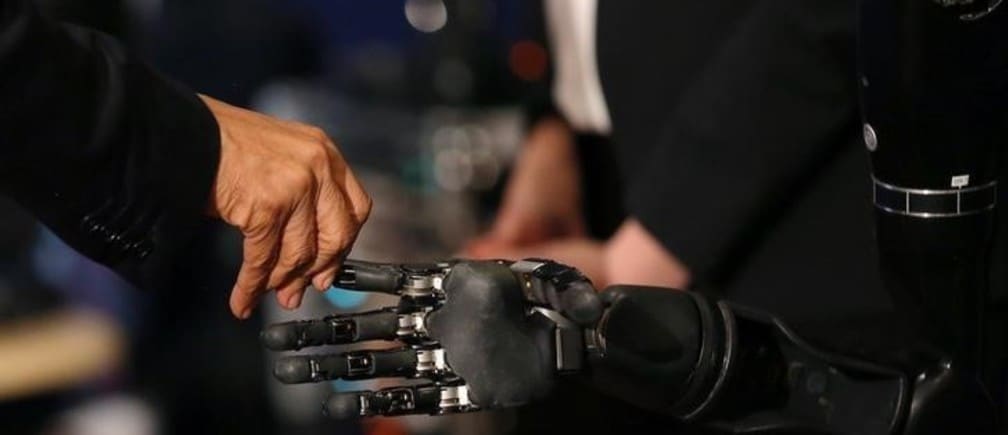Researchers have helped this paralysed man feel again

“I can feel just about every finger—it’s a really weird sensation.” Image: REUTERS/Carlos Barria
Nathan Copeland, a 28-year-old man who couldn’t feel or move his lower arms and legs after a car accident, has regained the sensation of touch through a robotic arm that he controls with his brain.
Copeland’s surgery, which involved implanting four tiny microelectrode arrays each about half the size of a shirt button in his brain, is a medical first.
The implants connect to the Brain Computer Interface (BCI), developed by researchers at the University of Pittsburgh. The team describes the results in Science Translational Medicine.
“The most important result in this study is that microstimulation of sensory cortex can elicit natural sensation instead of tingling,” says study coauthor Andrew B. Schwartz, professor of neurobiology and chair in systems neuroscience. “This stimulation is safe, and the evoked sensations are stable over months.
“There is still a lot of research that needs to be carried out to better understand the stimulation patterns needed to help patients make better movements.”
This is not the team’s first attempt at a BCI. Four years ago, study coauthor Jennifer Collinger, assistant professor in physical medicine and rehabilitation, and research scientist for the VA Pittsburgh Healthcare System, and the team demonstrated a BCI that helped Jan Scheuermann, who has quadriplegia caused by a degenerative disease. The video of Scheuermann feeding herself chocolate using the mind-controlled robotic arm was seen around the world. Before that, Tim Hemmes, paralyzed in a motorcycle accident, reached out to touch hands with his girlfriend.
But the way our arms naturally move and interact with the environment around us is due to more than just thinking and moving the right muscles. We are able to differentiate between a piece of cake and a soda can through touch, picking up the cake more gently than the can. The constant feedback we receive from the sense of touch is of paramount importance as it tells the brain where to move and by how much.
For study leader Robert Gaunt, assistant professor of physical medicine and rehabilitation, that was the next step for the BCI.
As Gaunt and colleagues were looking for the right candidate, they developed and refined their system such that inputs from the robotic arm are transmitted through a microelectrode array implanted in the brain where the neurons that control hand movement and touch are located. The microelectrode array and its control system, which were developed by Blackrock Microsystems, along with the robotic arm, which was built by Johns Hopkins University’s Applied Physics Lab, formed all the pieces of the puzzle.
Copeland’s story
In the winter of 2004, Copeland, who was 18 at the time, was driving at night in rainy weather when he was in a car accident that snapped his neck and injured his spinal cord, leaving him with quadriplegia from the upper chest down.
After the accident, he had enrolled on a registry of patients willing to participate in clinical trials. Nearly a decade later, the research team asked if he was interested in participating in the experimental study.
After he passed the screening tests, Copeland was wheeled into the operating room last spring. Imaging techniques were used to identify the exact regions in Copeland’s brain corresponding to feelings in each of his fingers and his palm.
“I can feel just about every finger—it’s a really weird sensation,” Copeland said about a month after surgery. “Sometimes it feels electrical and sometimes its pressure, but for the most part, I can tell most of the fingers with definite precision. It feels like my fingers are getting touched or pushed.”

At this time, Copeland can feel pressure and distinguish its intensity to some extent, though he cannot identify whether a substance is hot or cold, explains study co-investigator and neurosurgeon Elizabeth Tyler-Kabara.
Gaunt says everything about the work is meant to make use of the brain’s natural, existing abilities to give people back what was lost but not forgotten.
“The ultimate goal is to create a system which moves and feels just like a natural arm would,” says Gaunt. “We have a long way to go to get there, but this is a great start.”
The Defense Advanced Research Projects Agency’s Revolutionizing Prosthetics program provided most of the funding.
Don't miss any update on this topic
Create a free account and access your personalized content collection with our latest publications and analyses.
License and Republishing
World Economic Forum articles may be republished in accordance with the Creative Commons Attribution-NonCommercial-NoDerivatives 4.0 International Public License, and in accordance with our Terms of Use.
The views expressed in this article are those of the author alone and not the World Economic Forum.
Stay up to date:
Health and Healthcare
Related topics:
Forum Stories newsletter
Bringing you weekly curated insights and analysis on the global issues that matter.
More on Emerging TechnologiesSee all
Dr Gideon Lapidoth and Madeleine North
November 17, 2025






